Why Is Rouen Such an Attractive City?
Posted by Ariane on Oct 23, 2013 in Countries, France | 2 comments
Summary: One of the most attractive cities in Normandy —and our favorite—is Rouen, where we had the chance to spend five weeks. What is so special in the city, and what kind of treasures does it hide? Let us tell you about the city where Joan of Arc, Pierre Corneille, and Gustave Flaubert fulfilled their destinies.
“Rouen has an unique historical heritage, but the thing the visitors will feel above all is the soul of the city.” This is the first sentence of the summary written on the tourist map of the city, and I must admit that I can’t find any better way to describe Rouen.
Indeed, every traveler knows that a city is not only a collection of people, streets, history, buildings, and houses, but that it is the mixture of all these elements that makes the city attractive or not, and that gives it a special atmosphere, like the one mentioned above.
Rouen is a mysterious city—historical but modern, calm but animated, cosmopolitan but typically French. The city of Rouen is very rich, not only because of its history, but also thanks to its current dynamism.
Hundreds of Years: Here Is the History of Rouen
The city of Rouen was built during antiquity, and since then the years have brought their share of events, and thus shaped the city. What amazes me the most in Rouen is how easily you can feel the vibrations of the past centuries. You just have to walk around and then suddenly, on a street corner, arriving at a square, or in front of an old house, it is as if you have been taken back in the past. Of course, the half-timbered houses and the very old architecture of some of the buildings may have something to do with this phenomenon. There is also this very special smell of old masonry (houses) that you can smell in some streets, and that kind of keeps the past alive as well.
Like layers superimposed on each other, the successive ages have left their marks on the city.
The Seine River
Rouen is located on the banks of the Seine River, so the city is separated into the “right bank” and “left bank.” The old city is on the right bank. For me, any place where there is a river always holds more charm and interest than other places. The bridges that connect the two parts of the city to each other are of course a big part of this charming appearance, and give the city another dimension.
The Living Souls of Rouen
Another charming aspect of Rouen is the diversity of its communities. Rouen is a middle city, with the advantages of both the big cities and the countryside towns, and this attracts a lot of people. This variety gives Rouen a lot of dynamism and makes the city very active. There is also a huge amount of visitors all year long.
In Rouen you will also be able to see the diversity and richness of different cultures merged into one big city.
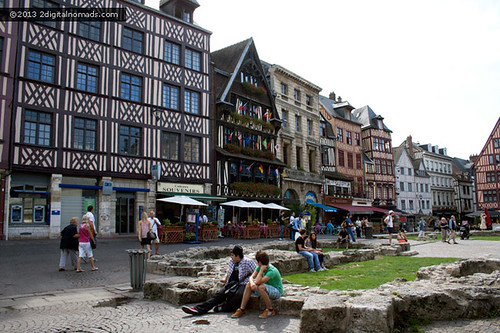
Place du Vieux Marché where you can see the oldest restaurant in France (the darkest building in the middle)
The Big Old Bricks, aka Monuments
In Rouen, around every corner and under every stone there is a story to tell. Rouen is filled with different monuments—like all of France—and they are all beautiful. Here are a few to whet your appetite:
The Cathedral Notre Dame
This cathedral has the highest spire in France.
The Gros Horloge
The Gros Horloge, the emblem of Rouen, is located on the street of the same name (rue du Gros Horloge). The mechanism of the clock dates from to 13th century.
The Bureau des Finances
It is the current Office de Tourisme just in front of the cathedral.
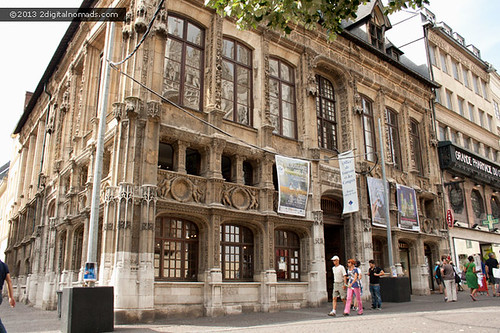
The Bureau des Finances
Joan of Arc Tower
The tower is near the train station. Joan of Arc spent several months there during her trial.
St-Ouen Abbey
The Palais de Justice
This is another middle age monument.
The Place du Vieux Marché
The square where Joan of Arc was burnt. A beautiful modern cathedral has been built at the location of the woodshed. You should walk inside, as the stained glass is really nice.
In the same square you can see two other famous buildings: the house where the famous writer Pierre Corneille was born (rue de la Pie), and the oldest auberge (hostel) in France.
The Saint Maclou Church
L’Eglise Saint Maclou.
Saint Maclou Aster-L’aître Saint Maclou
Near the church lies one of the oldest groups of houses in Europe. It is also a testimonial to the black plague that devastated the city in 1348.
The Hôtel of Bourgtheroulde
This is an old mansion that is now a five-star hotel.
Shopping in Rouen: What to Bring Home
You will find many shops downtown, and all of your favorite brands. There are also some shopping malls, like Saint Sever (left bank).
There are several stores that specialize in selling products made in Rouen, such as Rouen faïence and porcelain, which is a kind of pottery made of porcelain, and which you can find next to the cathedral Notre Dame. You can also buy the very Norman “Heula!” souvenirs —a new brand destined to show Normandy and all of its aspects in a funny way. You will find post cards, cups, umbrellas, T-shirts, and a lot more. I love the brand!
Eating in a 500-Year-Old Restaurant: How Does It Feel?
You don’t have to worry about restaurants and food in Rouen—you’re in France, after all! You will just have trouble picking a place to eat! You will find French cuisine, pizzas, seafood, Oriental, Asian, fast food, bakeries, sandwiches, ice creams—everything for all tastes and all budgets.
Rouen remains our favorite city in France, so we hope this post will inspire you to come and visit the city. As I mentioned at the beginning of the article, there is a lot to say, but you’ll have to come enjoy and feel it yourself!
Have you been to France? Is it on your bucket list?


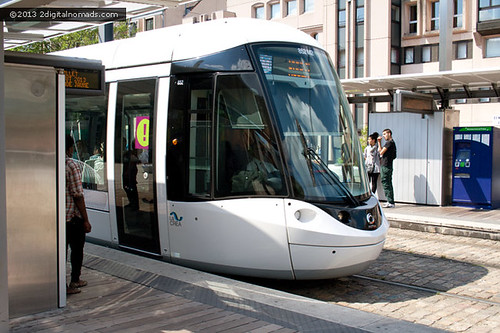
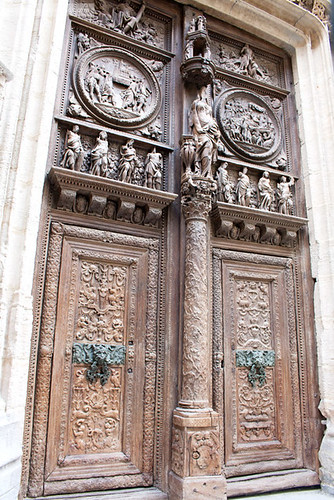
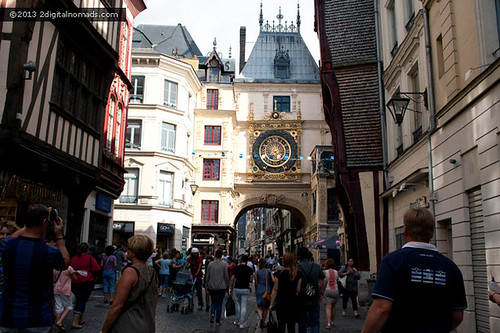
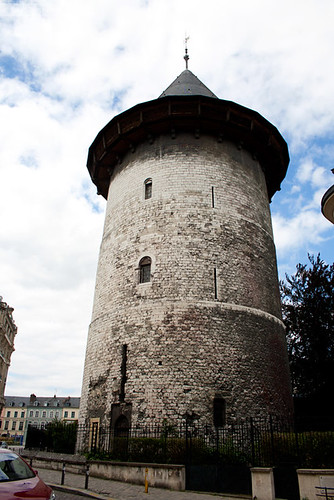
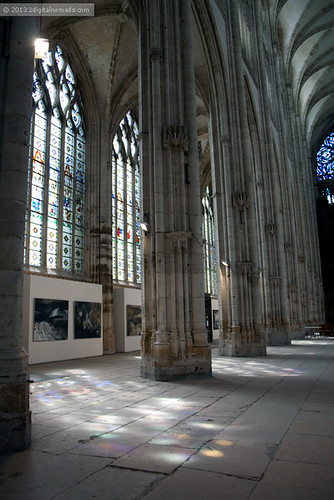
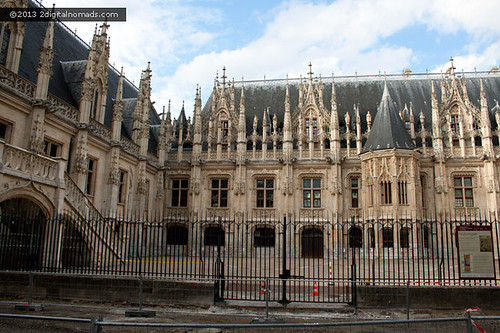
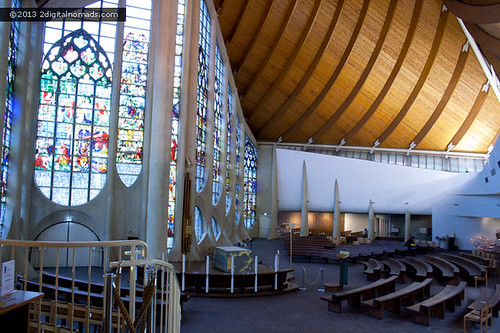
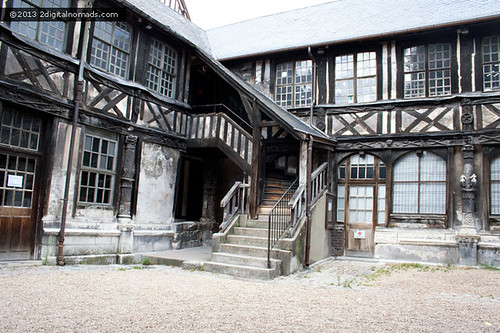
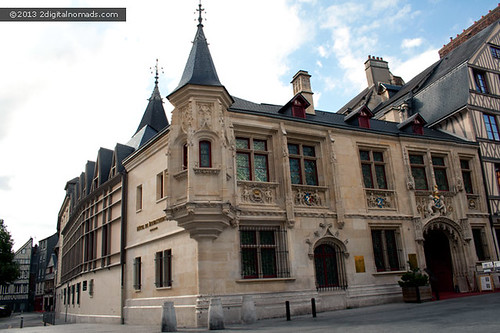
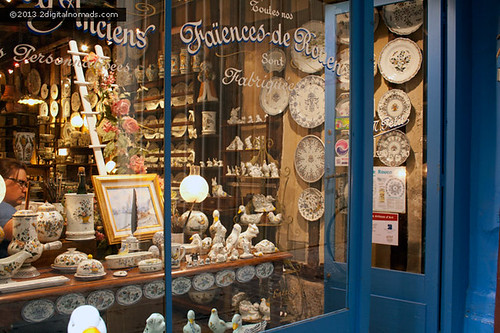
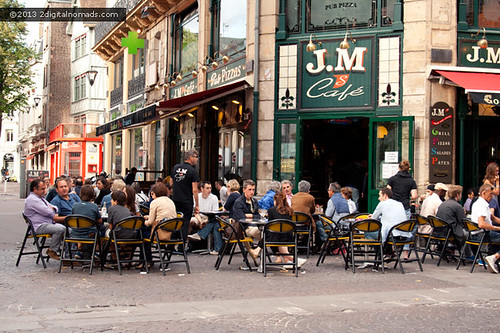
 Bassel & Ariane, a couple who quit their jobs to realize their dream "traveling around the world". This travel website is our way to share with you the amazing adventures we have had, with the goal of helping to make your own travels more enjoyable.
Bassel & Ariane, a couple who quit their jobs to realize their dream "traveling around the world". This travel website is our way to share with you the amazing adventures we have had, with the goal of helping to make your own travels more enjoyable.
Great informative post on Rouen! Janice spent a day in Rouen while on a Siene river cruise. Rouen doesn’t have the touristic cache of Paris, or Avignon, or Nice – but the city is actually a very pleasant surprise!
Sand In My Suitcase recently posted…Bargaining part of the shopping fun in Mexico
Hi George,
Thanks for your comment and for your tweet. We are glad that Janice liked Rouen, your turn to visit!